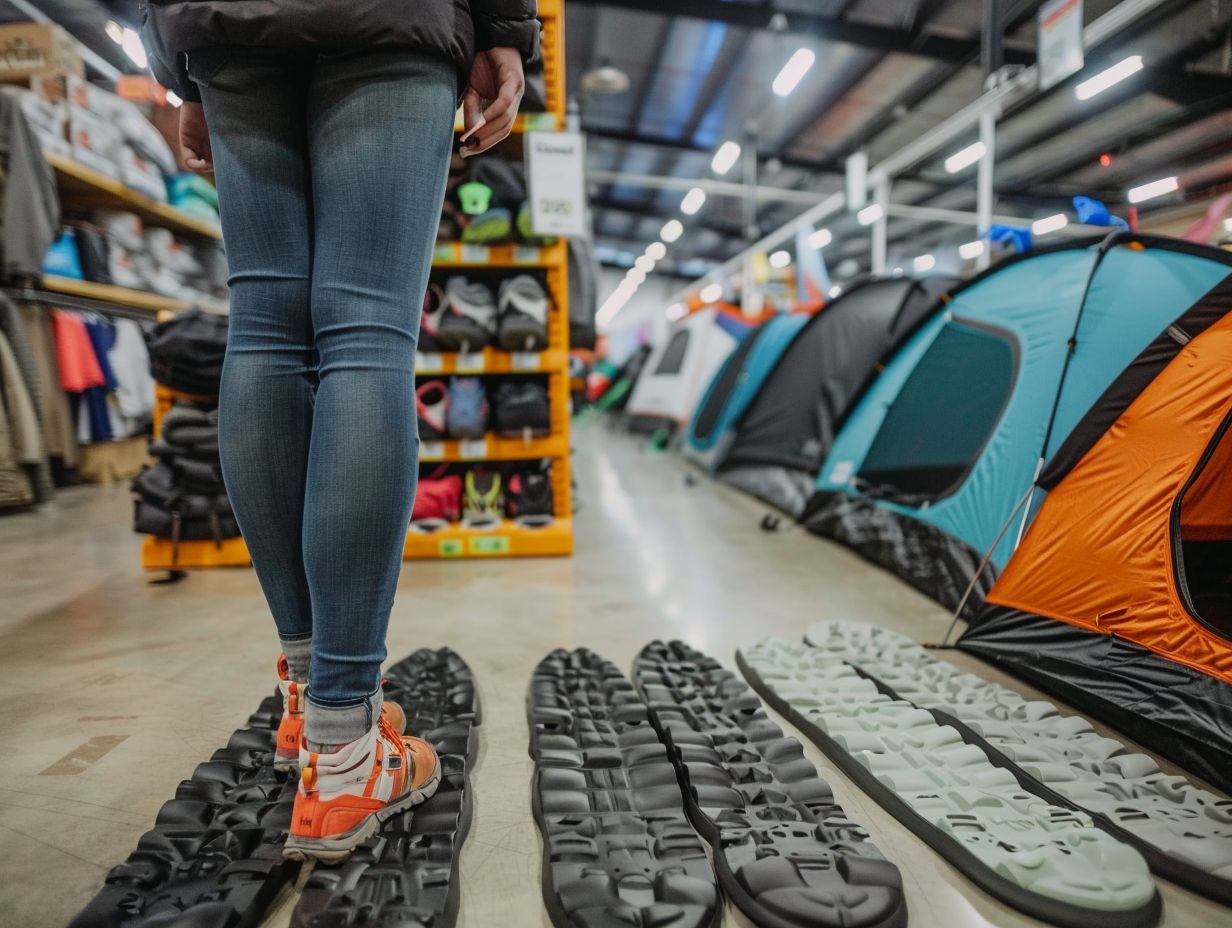Looking to protect your tent from wear and tear during outdoor adventures? Choosing the right tent footprint is crucial for extending the life of your shelter.
We discuss factors to consider when selecting a tent footprint, such as material, size, shape, weight, durability, and price. Explore different types of tent footprints available, including standard, custom, and ultralight options.
Get tips on how to properly use and care for your tent footprint to ensure its longevity. If you want to make the most of your camping gear, keep reading to learn more!
Key Takeaways:

- A tent footprint is important for protecting your tent and providing a barrier between it and the ground.
- When choosing a tent footprint, consider factors such as material, size, shape, weight, durability, and price.
- Tent footprints come in standard, custom, and ultralight types, each with their own benefits.
Factors to Consider When Choosing a Tent Footprint
When choosing a tent groundsheet, it is essential to consider multiple crucial factors, such as the material, dimensions, configuration, weight, strength, and cost, in order to ensure its compatibility with your tent and camping preferences.
1. Material
The choice of material for a tent groundsheet is crucial as it greatly impacts its performance. Popular options such as Polycryo, Tyvek, and nylon are favoured due to their distinct properties and varying denier ratings.
Polycryo is renowned for its exceptional durability and lightweight nature, making it a preferred choice among backpackers who prioritize a minimalist groundsheet. However, its susceptibility to punctures and tears in rugged terrains is a notable drawback.
Conversely, Tyvek offers outstanding tear resistance and waterproofing capabilities, rendering it suitable for harsh conditions. Nevertheless, it tends to be heavier than Polycryo.
Nylon fabrics, available in different denier ratings, provide a balance between durability and weight, making them suitable for a wider range of camping preferences.
2. Size
Selecting the appropriate size for your tent groundsheet is essential, as it should correspond to the dimensions of your tent’s floor to offer optimal protection without exceeding its edges. A precise alignment between the tent groundsheet and the tent’s floor serves various functions beyond mere protection.
When the groundsheet aligns perfectly with the tent base, it helps prevent any surplus material from protruding, thereby decreasing the risk of tripping or entanglement.
To accurately measure your tent floor, lay it out flat and utilise a measuring tape to ascertain its length and width. Ensuring a snug fit will avert potential issues such as water accumulation beneath the tent during rainy conditions, which could result in discomfort and damage to your camping equipment.
3. Shape
The configuration of a tent footprint should correspond with the tent’s floor plan, be it rectangular, square, or uniquely contoured, to ensure optimal ground coverage and protection. It is imperative to consider how the shape of a tent footprint correlates with the tent itself when making a selection.
For example, a rectangular footprint typically complements dome or cabin-style tents, facilitating a simple setup process and providing excellent protection against moisture.
Conversely, square footprints are suitable for tunnel or hooped tents, delivering a customised fit and additional reinforcement along the edges. Uniquely contoured footprints are ideal for specialised tents with irregular shapes, ensuring a snug and secure base for your shelter.
By aligning the footprint shape with the tent design, you enhance stability, weather resistance, and overall camping comfort.
4. Weight
Consideration of weight holds significant importance, particularly for enthusiasts of ultralight camping. In this context, where each ounce carries substantial weight, the appeal of lighter materials such as Polycryo for footprint weight reduction is undeniable.
When selecting lightweight footprints, the choice of material plays a pivotal role in achieving a balance between reducing weight and ensuring durability. Polycryo, characterized by its thin yet robust nature, offers commendable weight-saving advantages while maintaining strength.
Conversely, materials like silnylon, while providing enhanced durability, contribute additional weight. It becomes imperative for campers to assess their priorities according to their specific requirements – whether prioritizing weight reduction for extended hikes or opting for sturdier alternatives suitable for rugged terrains.
5. Durability

The durability of a tent groundsheet is vital for withstanding rough surfaces, such as rocks, and materials like Tyvek and high-denier nylon are renowned for their resilience.
These materials provide exceptional protection for the tent floor against abrasions and punctures, rendering them suitable for challenging terrains. Conversely, Polycryo, while lightweight, may not exhibit the same level of durability against sharp rocks or jagged surfaces.
In scenarios involving rocky or rough terrains, preference is given to Tyvek and high-denier nylon groundsheets due to their superior tear and abrasion resistance, ensuring prolonged utility. Environmental conditions significantly impact the longevity and performance of these materials, underscoring the importance of selecting the appropriate groundsheet based on the terrain’s characteristics.
6. Price
The price of a tent groundsheet plays a crucial role in the selection process, as there are options available across a range of budgets while still offering essential features.
The choice of materials in tent groundsheets can greatly influence their pricing. Nylon groundsheets are generally more cost-effective compared to silicone-coated nylon or Dyneema, which command higher price points due to their superior durability and lightweight characteristics.
When evaluating brands, established outdoor companies such as MSR, Big Agnes, and REI provide high-quality groundsheets at premium prices, whereas lesser-known brands may offer more economically priced alternatives.
To strike a balance between cost and quality, it is recommended to evaluate your requirements and frequency of usage. Investing in a durable groundsheet may prove to be more cost-efficient in the long term, ensuring the protection and longevity of your tent.
Types of Tent Footprints
Tent footprints are available in a variety of types, such as standard, custom, and ultralight footprints. Each type caters to distinct camping requirements and preferences. Leading brands in the market, including Big Agnes, Marmot Tungsten, and REI, offer a diverse selection of tent footprint options.
1. Standard Footprints
Standard footprints are commonly manufactured in pre-determined sizes to specifically accommodate a particular tent model, offering dependable protection and convenience for the majority of campers.
They are meticulously crafted to align with the dimensions of the corresponding tent, guaranteeing a precise fit and optimising coverage. This customised approach not only streamlines the installation process but also bolsters the overall durability of the tent by serving as a safeguard against rugged terrain and moisture.
Campers can rely on their standard footprint to shield the tent floor from damage, thereby prolonging the lifespan of their camping equipment. The efficiency of possessing a designated footprint reduces the time required for assembly, enabling outdoor enthusiasts to devote more attention to relishing their outdoor escapades.
2. Custom Footprints
Custom footprints are meticulously crafted to accommodate the exact dimensions of your tent, delivering a personalised solution that enhances protection and performance.
Utilising a custom footprint designed specifically for your tent ensures a precise match with the shape and size of your shelter, offering superior coverage against moisture, dirt, and debris.
This customised fit not only helps to shield the tent floor from damage but also prevents water infiltration during inclement weather conditions. A bespoke footprint diminishes the likelihood of abrasions and punctures, thereby extending the longevity of your tent.
The implementation of a tailored footprint eliminates the need for guesswork in finding a universal fit and guarantees a snug and secure attachment tailored to the specifications of your particular tent model.
3. Ultralight Footprints
Ultralight footprints, commonly constructed from materials such as Polycryo, are meticulously engineered to deliver minimal weight without compromising on durability, making them an ideal choice for backpackers and enthusiasts of ultralight camping.
The significance of weight management in ultralight camping is paramount, as the reduction of carried gear weight can markedly enhance the overall camping experience. Embracing ultralight footprints, such as those meticulously crafted from Polycryo, allows campers to achieve substantial weight reductions while ensuring optimal protection.
These footprints serve as a protective boundary between the tent floor and the ground, providing protection against moisture, sharp rocks, and other abrasive terrain. This additional layer of defence not only guarantees a restful night’s sleep but also extends the tent’s lifespan by mitigating damage and abrasion.
How to Properly Use a Tent Footprint
Using a tent groundsheet effectively involves following several steps to ensure optimal protection and enhance the waterproof material’s effectiveness, thereby extending the lifespan of your tent and shelter.
1. Lay Out the Footprint

The primary step in utilising a tent footprint involves laying it out flat on the ground before proceeding with setting up the tent, ensuring that it is devoid of debris and aligned accurately.
This initial procedure plays a critical role in safeguarding the tent floor against punctures, moisture, and dirt, ultimately leading to an extended lifespan of the camping gear. When selecting an appropriate location to position the footprint, it is recommended to choose a level area with uniform ground to guarantee stability and comfort throughout the camping excursion.
Before siting the footprint, it is advised to clear the ground of any sharp objects or rocks that could potentially cause damage. It is advisable to consider utilising a ground cloth or tarp beneath the footprint to provide additional protection against abrasions and moisture.
Implementing these precautionary measures will contribute to the preservation of the tent’s structural integrity and enhance the overall camping experience.
2. Secure the Footprint
It is essential to properly secure the tent footprint during camping to prevent it from shifting. This can be accomplished by using pegs or weighting it down with rocks or other heavy objects.
An alternative effective method for securing the tent footprint involves the use of adjustable straps or clips attached to the corners of the footprint. These straps or clips can be tightened securely to the ground, ensuring a snug fit and reducing the likelihood of the footprint moving.
Some campers may choose to utilise reflective guy ropes for securing the tent footprint. These ropes not only serve the purpose of securing the footprint but also enhance visibility in low light conditions.
Ensuring that the footprint remains in place is crucial for maintaining the cleanliness of the tent floor, facilitating proper water runoff, and preventing any potential issues related to water pooling underneath the tent.
3. Place the Tent on Top
After securing the footprint, proceed to position the tent atop it, ensuring alignment with the edges of the footprint to guarantee comprehensive coverage and optimal protection for your shelter.
- Accurately positioning the tent on the footprint is essential for establishing a robust and weather-resistant setup. By aligning the tent’s edges with those of the footprint, a protective barrier is created to safeguard the tent floor against sharp objects, moisture, and potential damage. This alignment not only enhances the tent’s protective capacities but also aids in extending its lifespan by minimising fabric wear and tear.
- Precise placement also facilitates the maximisation of interior space within the tent, thereby enhancing the overall comfort level of the camping experience.
4. Tuck in Excess Footprint
It is recommended that any excess footprint material be tucked beneath the tent to prevent the accumulation of water and debris, which could potentially compromise the waterproof capabilities of the tent.
During the tent setup process, it is important to ensure that the edges of the footprint are neatly tucked under the tent floor. This simple yet crucial step plays a significant role in preventing water pooling, especially during rainy conditions.
Failure to tuck in the excess material leaves it exposed, creating a potential reservoir for rainwater and debris, ultimately leading to leaks and a less-than-ideal camping experience. By taking the time to properly secure the footprint, one can effectively enhance the overall performance and durability of the tent.
How to Care for a Tent Footprint
Ensuring the longevity and effectiveness of your tent footprint is imperative, requiring consistent care and maintenance. This includes regular cleaning, timely repairs, and the implementation of protective measures during camping excursions.
1. Clean and Dry Before Storage
Before storing the tent groundsheet, it is imperative to thoroughly cleanse it of any dirt and debris and ensure its complete dryness to mitigate the risk of mould and milDew proliferation.
To cleanse the tent groundsheet, the first step involves laying it flat and delicately scrubbing it with a mild solution of soap and water. It is advised to abstain from using harsh chemicals or abrasive tools that could potentially compromise the integrity of the material.
Following this, the groundsheet should be rinsed meticulously with clean water and left to air dry entirely before the folding and storage process. This meticulous drying procedure is essential in averting the accumulation of moisture, a precursor to mould and mildew formation.
It is recommended to keep the cleaned and dried tent groundsheet in a cool, dry location shielded from direct sunlight to preserve its quality for subsequent outdoor expeditions.
2. Repair Any Damage
Ensuring the continued functionality and effectiveness of your tent groundsheet involves promptly addressing any damage it may sustain through the utilisation of materials like Tenacious Tape. Regular inspections are essential in the identification of common types of damage, such as tears, punctures, or fraying.
To address tears, a durable solution can be achieved by applying a patch of Tenacious Tape on both sides of the tear. In the case of punctures, a similar method can be used to apply a patch, ensuring a waterproof seal. For fraying edges, the application of a seam sealer can provide reinforcement to the weakened area.
By promptly addressing these issues, the lifespan of your tent groundsheet can be extended, allowing it to withstand outdoor conditions effectively for an extended period of time.
3. Use Groundsheet Protectors

The use of groundsheet protectors is a highly effective method for safeguarding the footprint of your tent from excessive wear and tear that can occur during camping, ultimately enhancing the overall durability and performance of the tent.
These protectors serve as an additional layer of defence against sharp rocks, sticks, and moisture, thereby extending the lifespan of your tent.
When choosing a groundsheet protector, it is advisable to select a material known for its durability, such as reinforced polyethylene or heavy-duty fabric, which can withstand rugged terrain.
It is important to ensure that the size of the groundsheet protector matches the dimensions of your tent to guarantee complete coverage. Properly securing the protector beneath your tent is essential in preventing any shifting during use, thereby preserving its protective barrier.
Regular maintenance of the groundsheet protector, including cleaning and drying it on a consistent basis, is crucial to prevent the growth of mould and to ensure the protector’s continued effectiveness over time.
Frequently Asked Questions
1. What is a tent footprint and why is it important to choose the right one?
A tent footprint is a groundsheet that is placed underneath a tent to protect it from the ground. It is important to choose the right one because it can prolong the life of your tent, provide additional insulation, and protect it from sharp objects and moisture.
2. How do I determine the correct size of tent footprint for my tent?
The size of the tent footprint should correspond to the size of your tent’s floor dimensions. You can either refer to the manufacturer’s specifications or measure the length and width of your tent and add a few inches to each measurement for a proper fit.
3. What materials are tent footprints made of and which one is the best?
Tent footprints can be made of various materials such as nylon, polyester, and polyethylene. The best material depends on the type of camping you do. For example, nylon is lightweight and ideal for backpacking, while polyethylene is more durable and suitable for car camping.
4. Are all tent footprints waterproof?
No, not all tent footprints are waterproof. Some may have a waterproof coating or come with a separate rain fly. It is important to read the product description and make sure the footprint you choose is waterproof if you plan on camping in wet or rainy conditions.
5. Can I use a tarp as a tent footprint?
While a tarp may seem like a cheaper alternative to a tent footprint, it is not recommended. Tarps are typically thicker and heavier, making them less portable and difficult to pack. They can also cause moisture to accumulate under your tent, leading to condensation and a damp sleeping surface.
6. Should I choose a tent footprint with or without grommets?
Both options have their advantages. Grommets allow you to secure the footprint to the ground with stakes, providing additional stability. However, footprints without grommets are more versatile and can be used as a ground cover or picnic blanket. Consider your camping needs and choose the option that best suits you.

